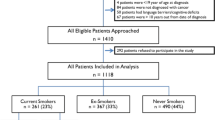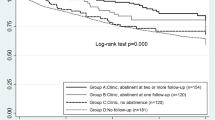Abstract
Although the benefits of smoking cessation following a cancer diagnosis have been well-established, up to 50% of cancer patients continue to smoke. Continued smoking through oncology treatment leads to increased risk of adverse events including reduced effectiveness of treatment, recurrence of additional malignancies, and reduced survival rates. Upon the cancer diagnosis, oncology healthcare providers become the primary trusted source of information and support, which represents a great opportunity to assist these patients to quit smoking. However, it remains unclear how oncology healthcare providers can best address smoking cessation from a patient-centered perspective. The present study surveyed oncology patients from Birmingham, AL, classified as either former (n = 174) or current smokers (n = 81) to identify their perceptions regarding the role of oncology healthcare providers in their smoking cessation efforts. Current smokers were more likely to be younger, received their cancer diagnosis within the past 3 years, and have a cancer diagnosis with high smoking-related public awareness (i.e., head, neck, or lung) compared to former smokers. Additionally, 81% of current smokers reported experiencing smoking cessation discussions with their oncology healthcare providers with the most prominent recommendations being use of nicotine replacement therapies (46.9%) and medication (35.8%). These smoking cessation experiences align with patient preferences. However, despite the frequency of smoking cessation discussions, current smokers demonstrated an ambivalence in understanding the risks of continued smoking during their medical treatment. Overall, this study highlights the important role of oncology healthcare providers on implementing smoking cessation intervention for their patients who continue to smoke.

Similar content being viewed by others
Data Availability
Not applicable.
Code Availability
Not applicable.
References
Gritz ER, Toll BA, Warren GW (2014) Tobacco use in the oncology setting: advancing clinical practice and research. Cancer Epidemiol Prevent Biomark 23(1):3–9
León X, del Prado Venegas M, Orús C, López M, García J, Quer M (2009) Influence of the persistence of tobacco and alcohol use in the appearance of second neoplasm in patients with a head and neck cancer. A case–control study. Cancer Causes Control 20(5):645–652
Park SM, Lim MK, Jung KW, Shin SA, Yoo KY, Yun YH, Huh BY (2007) Prediagnosis smoking, obesity, insulin resistance, and second primary cancer risk in male cancer survivors: National Health Insurance Corporation Study. J Clin Oncol 25(30):4835–4843
Parsons A, Daley A, Begh R, Aveyard P (2010) Influence of smoking cessation after diagnosis of early stage lung cancer on prognosis: systematic review of observational studies with meta-analysis. Bmj 340
Warren GW, Marshall JR, Cummings KM, Zevon MA, Reed R, Hysert P, Mahoney MC, Hyland AJ, Nwogu C, Demmy T, Dexter E (2014) Automated tobacco assessment and cessation support for cancer patients. Cancer 120(4):562–569
Khullar D, Maa J (2012) The impact of smoking on surgical outcomes. J Am Coll Surg 215(3):418–426
Warner DO, Sarr MG, Offord KP, Dale LC (2004) Anesthesiologists, general surgeons, and tobacco interventions in the perioperative period. Anesth Analg 99(6):1766–1773
Weaver KE, Danhauer SC, Tooze JA, Blackstock AW, Spangler J, Thomas L, Sutfin EL (2012) Smoking cessation counseling beliefs and behaviors of outpatient oncology providers. Oncologist 17(3):455
Warren GW, Marshall JR, Cummings KM, Toll BA, Gritz ER, Hutson A, Dibaj S, Herbst R, Mulshine JL, Hanna N, Dresler CA (2013) Addressing tobacco use in patients with cancer: a survey of American Society of Clinical Oncology members. J Oncol Pract 9(5):258–262
Gosselin MH, Mahoney MC, Cummings KM, Loree TR, Sullivan M, King BA, Warren G, Hyland A (2011) Evaluation of an intervention to enhance the delivery of smoking cessation services to patients with cancer. J Cancer Educ 26(3):577–582
Duffy SA, Ronis DL, Valenstein M, Lambert MT, Fowler KE, Gregory L, Bishop C, Myers LL, Blow FC, Terrell JE (2006) A tailored smoking, alcohol, and depression intervention for head and neck cancer patients. Cancer Epidemiol Prevent Biomark 15(11):2203–2208
Park ER, Japuntich S, Temel J, Lanuti M, Pandiscio J, Hilgenberg J, Davies D, Dresler C, Rigotti NA (2011) A smoking cessation intervention for thoracic surgery and oncology clinics: a pilot trial. J Thorac Oncol 6(6):1059–1065
Wakefield M, Olver I, Whitford H, Rosenfeld E (2004) Motivational interviewing as a smoking cessation intervention for patients with cancer: randomized controlled trial. Nurs Res 53(6):396–405
Nayan S, Gupta MK, Strychowsky JE, Sommer DD (2013) Smoking cessation interventions and cessation rates in the oncology population: an updated systematic review and meta-analysis. Otolaryngol-Head Neck Surg 149(2):200–211
Schnoll RA, Zhang B, Rue M, Krook JE, Spears WT, Marcus AC, Engstrom PF (2003) Brief physician-initiated quit-smoking strategies for clinical oncology settings: a trial coordinated by the Eastern Cooperative Oncology Group. J Clin Oncol 21(2):355–365
Karam-Hage M, Cinciripini PM, Gritz ER (2014) Tobacco use and cessation for cancer survivors: an overview for clinicians. Cancer J Clin 64(4):272–290
Bluethmann SM, Basen-Engquist K, Vernon SW, Cox M, Gabriel KP, Stansberry SA, Carmack CL, Blalock JA, Demark-Wahnefried W (2015) Grasping the ‘teachable moment’: time since diagnosis, symptom burden and health behaviors in breast, colorectal and prostate cancer survivors. Psychooncology 24(10):1250–1257
Li WH, Chan SS, Wang KM, Lam TH (2015) Helping cancer patients quit smoking by increasing their risk perception: a study protocol of a cluster randomized controlled trial. BMC Cancer 15(1):1–8
Li WH, Chan SS, Lam TH (2014) Helping cancer patients to quit smoking by understanding their risk perception, behavior, and attitudes related to smoking. Psychooncology 23(8):870–877
Khariwala SS, Rubin N, Stepanov I, Nollen N, Ahluwalia JS, Nelson HH, Hatsukami DK, (2019) “Cold turkey” or pharmacotherapy: Examination of tobacco cessation methods tried among smokers prior to developing head and neck cancer. Head Neck 41(7): 2332–2339.
Davis JM, Thomas LC, Dirkes JE, Swartzwelder HS (2020) Strategies for Referring Cancer Patients in a Smoking Cessation Program. Inter J Environ Res Publ Health 17(17):6089
Heckman BW, Cummings KM, Stoltman JJ, Dahne J, Borland R, Fong GT, Carpenter MJ (2019) Longer duration of smoking abstinence is associated with waning cessation fatigue. Behav Res Ther 115:12–18
Heckman BW, Dahne J, Germeroth LJ, Mathew AR, Santa Ana EJ, Saladin ME, Carpenter MJ (2018) Does cessation fatigue predict smoking-cessation milestones? A longitudinal study of current and former smokers. J Consulting Clin Psychol 86(11):903
Mills EJ, Wu P, Lockhart I, Thorlund K, Puhan M, Ebbert JO (2012) Comparisons of high-dose and combination nicotine replacement therapy, varenicline, and bupropion for smoking cessation: a systematic review and multiple treatment metaanalysis. Ann Med 44(6):588–597
Kim CY, Paek YJ, Seo HG, Cheong YS, Lee CM, Park SM, Lee K (2020) Dual use of electronic and conventional cigarettes is associated with higher cardiovascular risk factors in Korean men. Sci Reports 10(1):1–10
Mravec B, Tibensky M, Horvathova L, Babal P (2020) E-cigarettes and cancer risk. Can Prevent Res 13(2):137–144
Hawari FI, Obeidat NA, Rimawi D, Jamal K (2019) Smoking cessation care can translate to lower hazard of death in the short-run in cancer patients-a retrospective cohort study to demonstrate the value of smoking cessation services within the treatment phase of cancer. BMC Cancer 19(1):1–10
Schnoll RA, Martinez E, Tatum KL, Weber DM, Kuzla N, Glass M, Ridge JA, Langer C, Miyamoto C, Wileyto EP, Leone F (2010) A bupropion smoking cessation clinical trial for cancer patients. Cancer Causes Control 21(6):811–820
Tammemägi MC, Berg CD, Riley TL, Cunningham CR, Taylor KL (2014) Impact of lung cancer screening results on smoking cessation. JNCI: J Natl Cancer Inst 106(6)
Funding
This project was funded through the Department of Psychiatry at the University of Alabama at Birmingham.
Author information
Authors and Affiliations
Corresponding author
Ethics declarations
Ethics Approval
All procedures were previously approved by the Institutional Review Board at the University of Alabama at Birmingham.
Consent to Participate
Informed consent was obtained from all participants prior to study procedures.
Consent for Publication
Not applicable.
Conflict of Interest/Competing Interests
All authors declare no competing interests
Additional information
Publisher's Note
Springer Nature remains neutral with regard to jurisdictional claims in published maps and institutional affiliations.
Rights and permissions
About this article
Cite this article
Schiavon, S., Davies, E., Mildrum Chana, S. et al. Oncology Patient Smoking Cessation Treatment Preferences: Perceptions Across Former and Current Cigarette Smokers. J Canc Educ 37, 1975–1981 (2022). https://doi.org/10.1007/s13187-021-02068-1
Accepted:
Published:
Issue Date:
DOI: https://doi.org/10.1007/s13187-021-02068-1




